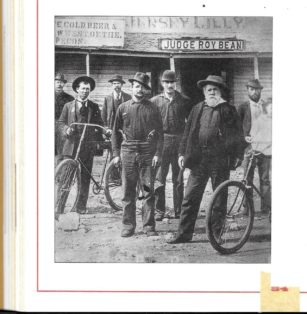Enter now to win a copy of
More Tales Behind The Tombstones:
More Deaths and Burials of the Old West’s Most Nefarious Outlaws,
Notorious Women, and Celebrated Lawmen

“I aim to shoot the hell out of anybody that tries to stop me. I aim to mind my own business, and aim to back up the law.”
—Judge Roy Bean
With the passing of Judge Roy Bean, who referred to himself as the “Law West of the Pecos,” the rowdy frontier lost one of its most unique and picturesque characters. It was Judge Bean that was said to have held an inquest on the body of an unknown man found in his precinct, and, finding on the corpse a pistol and $40 in cash, proclaimed the dead man guilty of carrying a concealed weapon and fined him $40, which was forthwith collected from the pocket of the offender.
There were no customers from Judge Roy Bean’s opera house and saloon by his side when he died on March 16, 1903; no friends from the Langtry, Texas, community where he had resided; no lawbreakers to be tried and sentenced. Judge Bean’s son, Sam, was the only one with him when he passed.
The stout, seventy-eight-year-old man with a gray beard spent his last hours on earth in a near comatose state unaware of where he was or who he was. He died of heart and lung complications exasperated by alcohol.
Roy was born in a cabin in Mason County, Kentucky, in 1823, but he spent his childhood in Independence, Missouri. He followed his older brother to the Southwest in 1846, and the pair opened a trading post in Chihuahua, Mexico.
In 1848, eighteen-year-old Roy killed a desperado trying to steal from him and fled the area to escape arrest. There were several more run-ins with the law between 1849 and 1862. In 1862, Roy decided to join the army to fight for the North in the Civil War. He married Virginia Chavez in 1866 and the couple settled in San Antonio, Texas. Roy and his wife had four children, but the marriage was rocky and didn’t last.
When the Southern Pacific Railroad began its extension from San Antonio to the Rio Grande, Roy followed the line with a moveable house that featured a saloon. During one of the rides he met an attorney from Chicago who regaled him with stories of how the justice system worked in the eastern states. The fascinating details of law and order stuck with Roy, and when he was appointed Justice of the Peace at a railroad stop in West Texas he decided to employ all he had learned from the Chicagoan.
Roy Bean gave the temporary railroad stop that grew into a town its name. He called the spot Vinegroon. A vinegroon is a whip-tailed scorpion common in that region. The name was appropriate as well as symbolic. “I aim to run a square place,” the judge informed all potential customers. “I aim to shoot the hell out of anybody that tries to stop me. I aim to mind my own business, and aim to back up the law.”
“What law?” some brave railroad worker ventured to ask. “There hasn’t been any sign of civilized law this far west yet.”
“My own!” Judge Bean roared. “I’m the law from now on. I’m the law west of the Pecos.”
Judge Roy Bean hung a sign in front of his establishment that read: “Roy Bean, Notary Public, Ice Cold Beer. Judge Roy Bean, Law West of the Pecos.” The railroad executives liked it. It was convenient and gave the railroad a location to tie themselves to, and somebody to punish thieves and other rowdy cowboys. Cattle ranchers came in fast, and they liked the semblance of law, too. They had no time to organize and hold elections, so they took Roy Bean on as the authority.

To learn about More Deaths and Burials of the Old West’s Most Nefarious Outlaws, Notorious Women, and Celebrated Lawmen read
More Tales Behind the Tombstones

